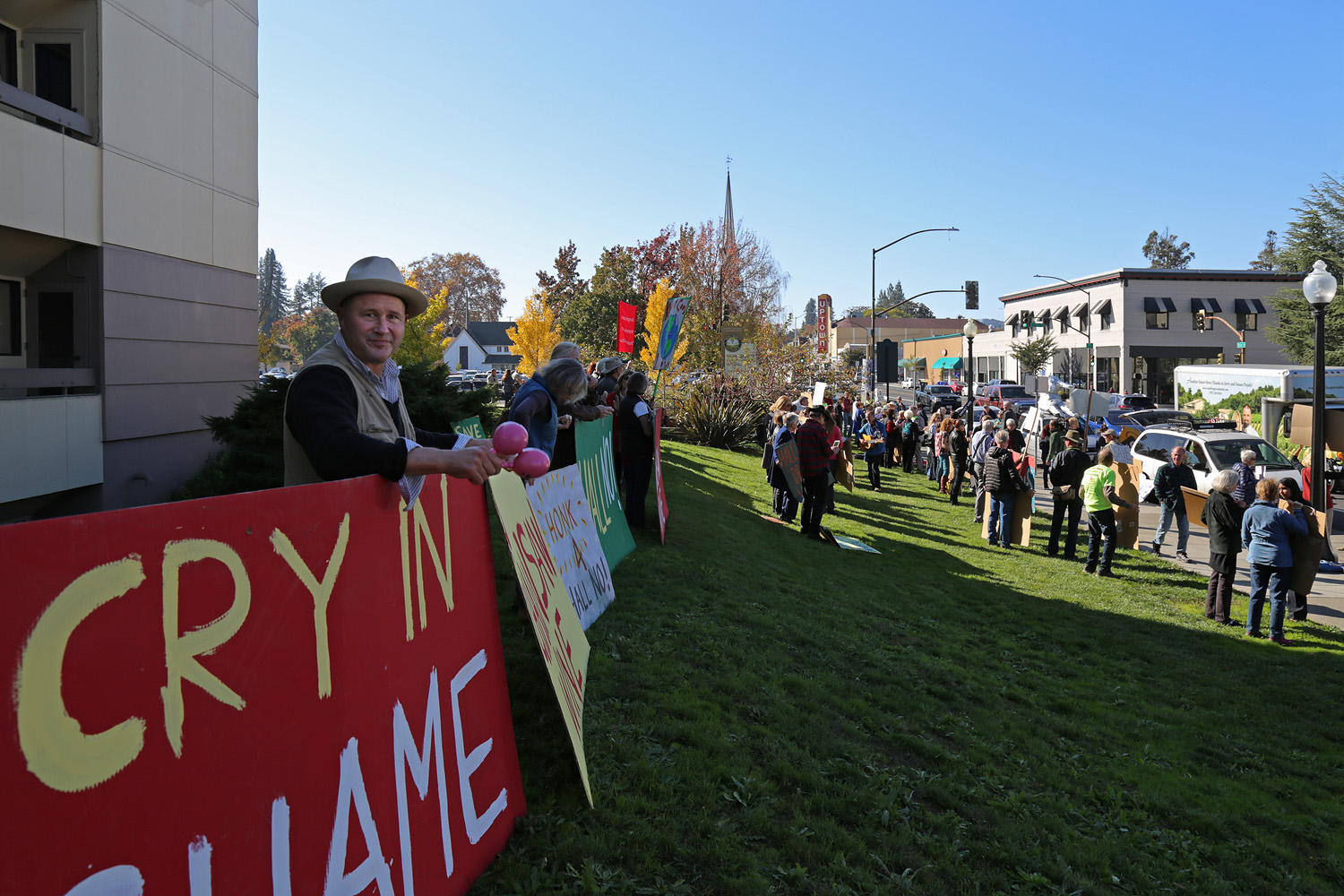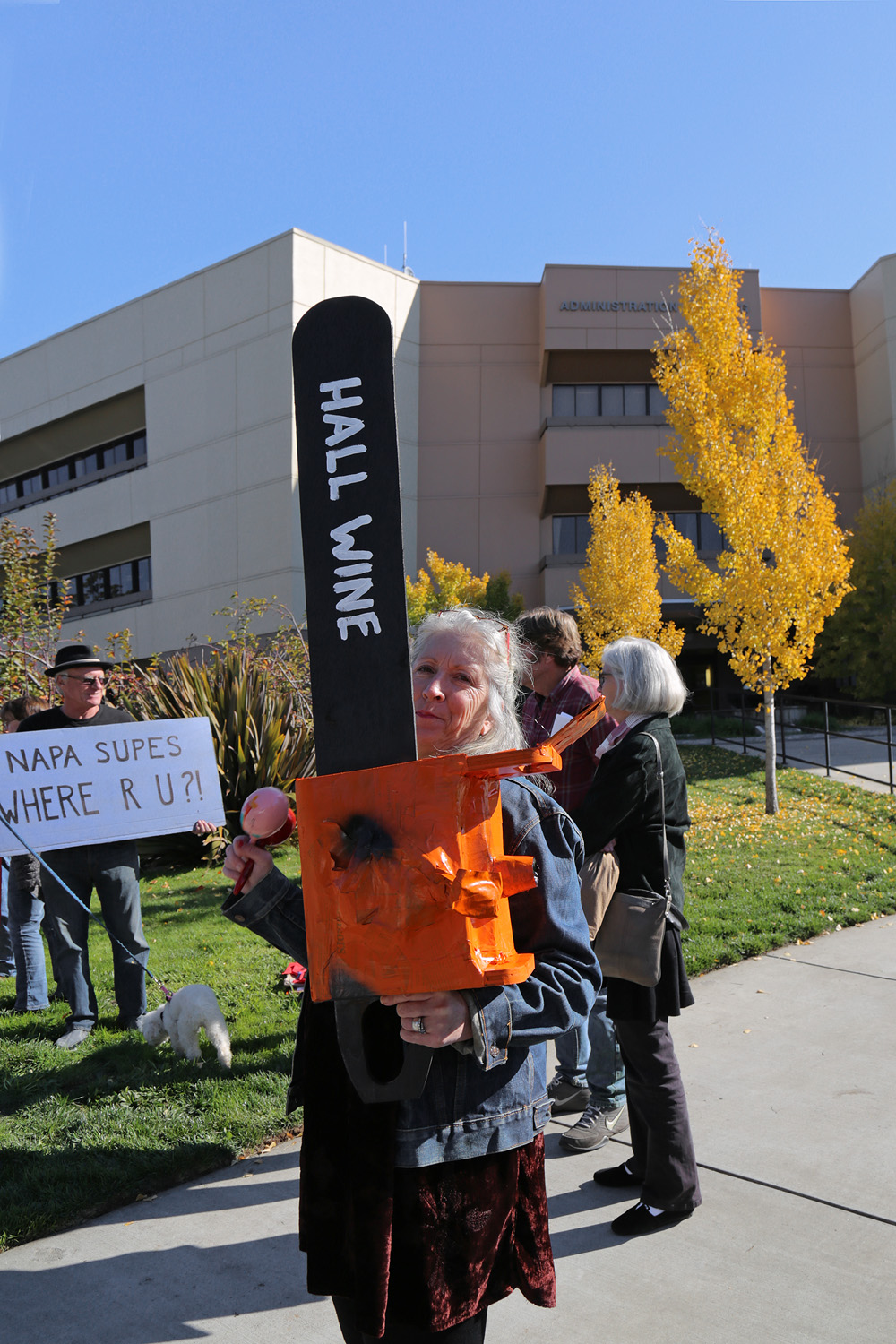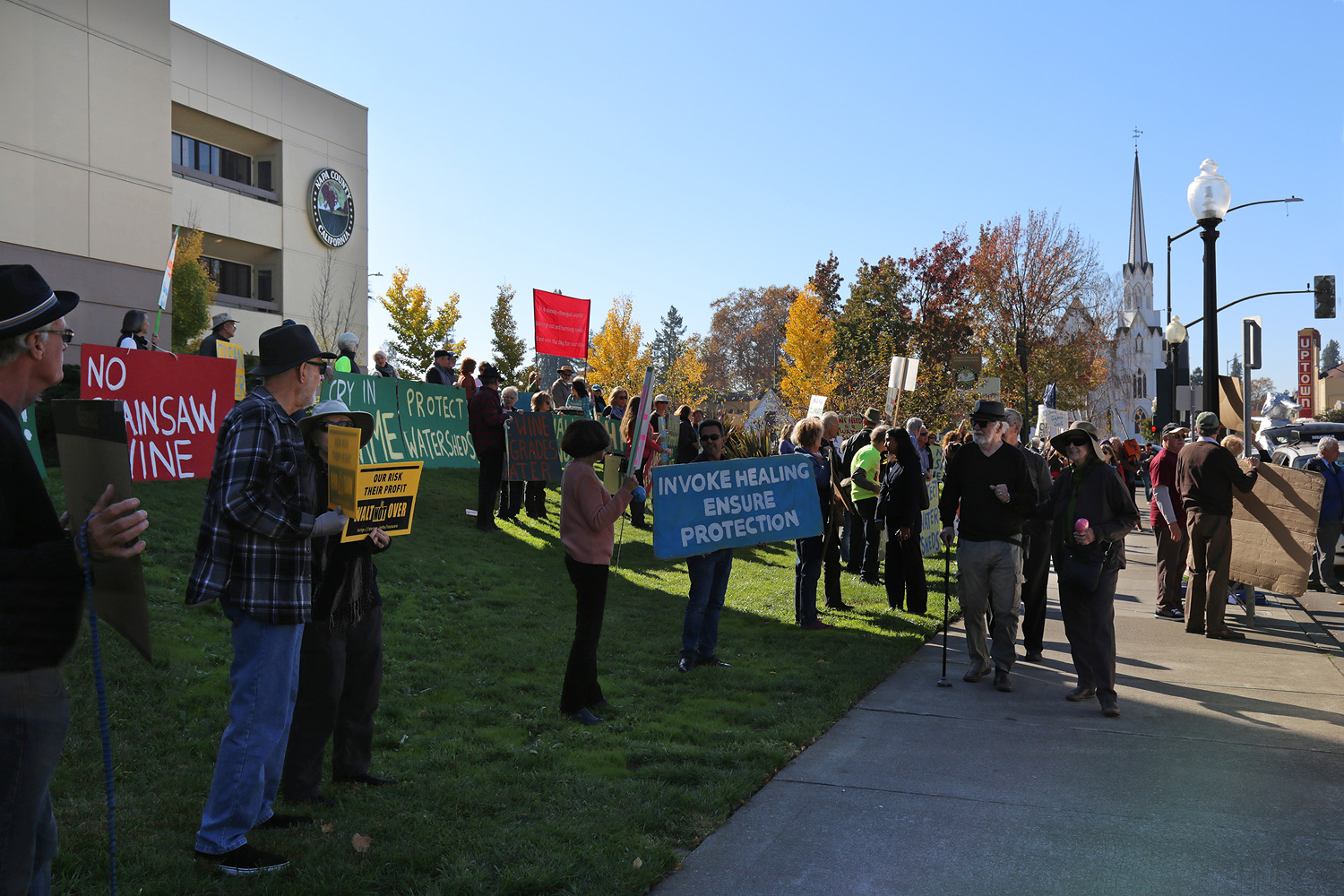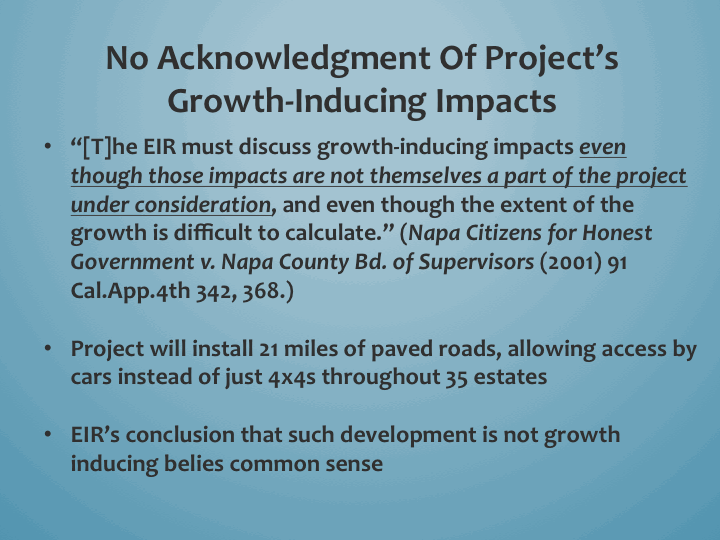
Walt Ranch Appeals Denied
on the web at: https://sodacanyonroad.org/forum.php?p=1340
Bill Hocker | Dec 20, 2016Day 4
NVR 12/20/16: Napa County supervisors complete Walt Ranch approvals
I was pleased to read that the Center for Biological Diversity also had taken up the issue of future development of the Walt properties for housing once a water system and all weather road system are in place. The county again apparently has dismissed such subsequent development potential as pure speculation, implying, as before, that the CEQA requirement to consider the growth inducing impacts of a project don't apply in this case becuse that owners haven't proposed a housing project.
Day 3
NVR 12/6/16: Napa County supervisors endorse controversial Walt Ranch
NVR 12/5/16: Napa supervisors poised to make Walt Ranch decision
Video of the day 3 hearing (12/4/16)
WIth modest discussion, they made their decision: ALL APPEALS DENIED 5-0
Kudos to Sup. Wagenknecht for bringing up the "speculative" possibility of home development on the 35 parcels of Walt Ranch. It is the first time that any public official or staff member has brought up the issue beyond the terse dismissal in the EIR that the developer didn't propose housing so we don't have to discuss it. In fact, once he raised the question about the probability of the vineyard development making the parcels more salable for home development and the impact that might have on water demand, there seemed to be an uncomfortable silence in the chamber as staff and supervisors mentally wrestled with a need to respond to a subject that has been completely taboo during the entire EIR process.
Staff seemed compelled to state that once the EIR was approved there would be no more public review of future home developments on Walt Ranch and that such development could proceed by right requiring only ministerial (non-public) decisions. Sup. Caldwell, pointing to the wide variety of development allowed by the zoning that could occur on the properties (including up to 105 dwelling units), asked for a clarification on the road upgrading that might be required. Dir. Morrison responded that the ministerial review would likely require the improvemment of roads to state mandated requirements but that was just more speculation. And then, after 8 years, this one and only brief governmental interest in the potential conversion of 2300 acres of virgin forested watershed into a housing project was dropped, and the project was approved.
Most interesting was Sup. Luce's impatient and enthusiastic motion to deny the appeals (and his ironic support of the development industry that had just kicked him out of office) as well as Sup. Dillon's "it's vineyards or houses, folks" canard [a pre-Internet post-truth] knowing that Walt Ranch will eventually be a vineyard estate housing development. She also ungraciously accused the appellants, whom she was about to hammer with her decision, of "post-truth" lying.
Day 2
NVR 11/23/16: Proponents of Napa's Walt Ranch make their case (day 2)
Video of day 2 hearing (11/22/16)
Day 1
NVR 11/18/16: Napa's Walt Ranch vineyard hearings open with protest (day 1)
Video of day 1 hearing (11/18/16)
NapaVision2050: Day 1 post-hearing statement with news links
Mark Wolfe summation for Sierra Club at hearing
As stated in my letter to the BOS prior to the hearing, my interest among the many negative impacts that this project promises are the "growth inducing impacts" that the construction of an all-weather road system and a water storage and distribution system to each of the 35 properties in the project which will encourage further development of the properties as estates after the vineyards are in. I was pleased to see several speakers take up that theme in the appelants' presentations and by speakers afterward.
John Rose from the Center of Biological Diversity, in his arguments against the EIR, made the clearest case yet concerning both CEQA's admonition against "piecemealing" of projects and the need to discuss "growth inducing impacts". Their enitire PowerPoint is here. The specific slides of concern to me are here:
In public comments after the appellants' presentations other speakers brought up the issue of reasonably foreseeable future development on the property:
Gordon Evans' statement:
- While outside the current scope of this particular vineyard project, I ask the Board to consider the intended future use of the property.
On Nov. 6, 2014 at a public meeting hosted by the Halls at the Meritage Resort, Craig Hall, after acknowledging that the ranch consisted of 35 separate parcels, expressed surprise that “there hasn’t been much focus or contention on this” and “we wouldn’t have bought the property had it not already been divided into 35 development parcels.”
Indeed, when you overlay the proposed vineyard locations on the existing parcels, you will note that they are placed in such a fashion as to provide most parcels with their own dedicated vineyard. I initially pointed this out at the Public Forum conducted by Mr. Morrison on Nov. 12, 2014, and again personally to Chairman Pedroza at a private meeting on Feb. 22 of this year.
So, in this context, Mr. Lippe’s comments this morning about “economic feasibility” take on a special meaning, because we’re not talking about just a vineyard project here. You only have to look at the Hall Ranches development in the Anderson Valley to see what the ultimate prize here looks like. $269,000 per acre of developed vineyard is a paltry sum compared to the potential value of 35 developed mini-ranches with established vineyards.
As good as Hall wine is, the economics of this Vineyard Conversion Project defy logic if it’s only intended for wine production. Rather, I submit it is a costly stepping-stone to a vastly more valuable investment.
I assure you, we haven’t seen the last of this battle.
Former Supervisor Ginny Simms' statement:
- I'm Ginny Simms and I'm rushing toward 90 at breakneck speed. I'm here to talk about the Walt Ranch EIR but I'm here really to talk to you. Because I'm bringing up some things that you all know, that you have all experienced just as a reminder. These 35 parcels I researched and most of them were created from about 1980 and a whole bunch of them in and around 1990. And they remained parcels that were not really sold or developed or anybody showing much interest. There was at that time no proof of water, no access roads to them and as a result they were not really in any sense marketable.
But something has changed. If [the county has] not looked at the potential for this being a subdivision, that is exactly where it's headed. The EIR did not examine the development - I think this is rich - because it was not proposed by the project applicant. In other words we don't have to look at that because he didn't mention it. I find that kind of odd.
The EIR regulations clearly state that you must look to the expected results of the decisions you make following the hearing and basically that the EIR needs to cover the obvious and predictible results of the action. And I submit to you that our zoning of AW is a predictible and obvious result. Today if this is approved, a zoning administrator looking at an application for a house on one of these parcels will grant it. He could also grant a small residential care facility, a hunting club, and RV park or camp ground. In short, the process this has gone through by asking only for the nature of this action, what's really happened is that the planning department become judge jury and, in the form of the zoning administrator, the executioner.
What we see now is that we have water to every parcel, we also have a road to every parcel, an all weather road to every parcel, and the market is obviously going to respond. In addition they don't have yet any right to use this water for irrigation and the 21 miles of exiting roads are available to anyone who wishes to buy a parcel. I want to warn you that you are heading us for the same kind of trouble you have all experienced with the Berryessa badly planned subdivisions.
Former Supervisor Kathryn Winter's statement:
 illustration: Bob Johnson
illustration: Bob JohnsonI'd like to address the limitations of the cumulative impact analysis for the Walt Ranch with its vineyards and 35 pre-existing parcels, each with the capacity to be developed at a future day and induce growth in rural areas. The County's responses to various appeals claim that preperation of the cumulative analysis is consistant with CEQA guidelines, and they did find cumulative impacts, and they suggested mitigations. The county asserts that all of the many CEQA issues have been mitigated to less-than-significant levels. We've all heard the comments about the impacts on wildlife, from construction of roads, impacts to surface and ground water, increased traffic, impacts on endangered and threatened species, fragmentation of habitat, noise and fencing, pesticide drift, water pollution, loss of old growth oak tress and land slippage on unstable slopes. We've heard that all. With a project this size it's unfathomable that all impacts can be mitigated to less-than-significant levels even though additional mitigations added by staff allow them to recommend such a finding. This is what concerns me.
In 12 years making land use decisions as a town council member, county planning commissioner, and county supervisor, I approved projects whose impacts were theoretically mitigated, yet the county is saddled with ever increasing impacts and their costs. We see the failure of mitigations like huge swaths of clearcut hillsides marching up the valley. We gave up and determined the traffic can not be mitigated. So it takes 60 minutes some days to drive 18 miles from Napa to St. Helena. We have 400 to 600 wineries yet more seek approval. Bit by bit we are eliminating habitat for wildlife, decimating forests and slowly destroying our environment because our elected leaders do not have courage to say "no" to the wine industry when it seeks to impose it's will on the community. Where is the vision to look at the true costs of environmental degredation on our health, roads, loss of species, decreased air quality and compromised quality of rural life. If not you, who else can help citizens when we express fears about over-development. Scientists say we are witnessing the sixth major extinction of species. We don't need to contribute to that in Napa County. We can dot every "i" and cross every "t" of an environmental document and still come away with an unsatisfactory result because we have not addressed the real issue, which is the carrying capacity of Napa County to support unlimited winery and vineyard growth.
Photos from day 1 protest

      |      |

copyright © sodacanyonroad.org




